About this blog: Durga Puja is one of the most important festivals not only in Bengal, but also in India. Have you ever wondered where the idols of the Gods and Goddesses are made? There is a small locality in North Kolkata where a community of potters live, known for their expertise in sculpting these idols from clay. This place is called Kumartuli or Kumortuli.
The moment we stepped in the alleys and by-lanes of this North Kolkata neighbourhood, we realised we had arrived at a different world. Steeped in traditions and heritage, the god-makers of Kumartuli or Kumortuli are silently giving shape to the divine. Kolkata is a fascinating city. With all its modernity, she also fiercely guards her heritage. For those who are strangers to Kolkata and Durga Puja, Kumartuli will just be a name. But for us, Kumartuli is one such place where history, heritage and divinity have seamlessly merged into each other.
Durga Puja is the most famous festival of Kolkata. During these five days of festivities, Kolkata adorns in the best possible way and so are her residents. Durga Puja is no longer a religious festival of the Hindus, but it has become a carnival and a social festival. And Kumartuli is inexorably related to Durga Puja.
Kumartuli is an amazing place. In the maze of lanes between Sovabazar and Ahiritola, the gifted artisans are continuously creating their masterpieces and bringing the Gods and Goddesses on earth. The neighbourhood supports not only the potters who make idols, but also the many other artisans and traders related with the process of idol making. There are small shops selling the embellishment and ornamentations used to decorate the idols, while some shops are selling clothes that are used as sarees and dhotis on the idols. Kumartuli was and is still the largest hub of Durga idols in Bengal.

Where is Kumortuli located?
Chitpur is said to be one of the city’s oldest roads and brings the history of old Calcutta to life. With time, the area around Chitpur grew into habitations and a network of lanes and bylanes burgeoned from Chitpur Road itself. One such lane leading from Chitpur Road going towards the Hooghly River goes to the small neighbourhood of Kumartuli. Today, Banamali Sarkar Street is the official address of Kumartuli.
Kumartuli is named after the potters (kumars or kumbhakars) who had settled in the area.
Some of the most famous Bengali elites of the eighteenth century lived in Kumartuli. Nandaram Sen and Gobindaram Mitra amassed a lot of wealth working as the deputy to English collectors. They were known as the black zamindars.

Durga Puja and the history of Kumartuli
During the early eighteenth century, the British East India Company was gradually finding its foothold in Charnock’s Calcutta and spreading their trade. During this time, some of the affluent Hindus became money lenders to the Company along with the Armenians who were already in Bengal. Another group of enterprising Bengalis, though less prosperous became tradesmen and businessmen. The rest served as servants, labourers and messengers in the White Town.
These newly wealthy Bengalis developed the Black town by investing in lands and setting up bazaars (markets). The area round Chitpur became the Black Town. It was as if a city within a city. These colonies were named after landmarks or the occupations of the people. The chicken (murgi) market was named Murgihata, the tailors’(darji in Bengali) neighbourhood was named Darjipara, the tanners and cobblers (muchi in Bengali) occupied the Muchipara while the twin (jora) bridges (sanko) over a creek was distinguished as Jorasanko. Kumartuli was thus the home of the kumars (potters) who would fashion the clay obtained from the river beside their houses into pots and sold them at Sutanuti market.
The initiation of idol making at Kumartuli has a popular lore behind it. In 1757, Lord Clive defeated Siraj-ud-daula at the Battle of Plassey, an incident that sealed the fate of the British in India. It is said that Robert Clive wanted to pay obeisance to God, but the only church in Calcutta, St. Anne’s Church had been demolished during the siege of the town. Sri Nabakrishna Deb of Sovabazar, a well wisher and consultant of Clive suggested him to make an offering at the feet of Goddess Durga at his house in Sovabazar. Following this, Durga Puja was arranged the following Aswin month at Sovabazar. The annual Durga Puja at 36, Nabakrishna Street is still known as “Company Puja”.
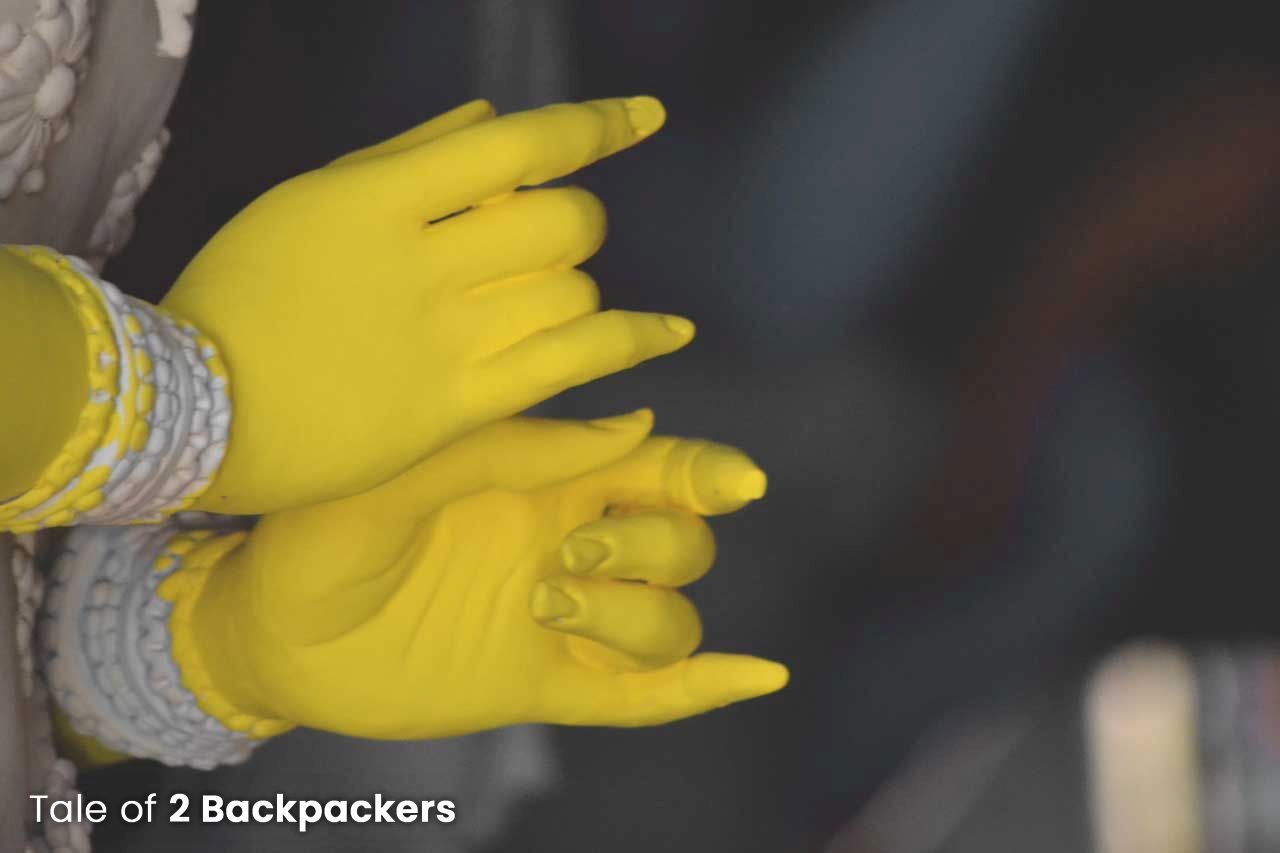
As the city became wealthy, the nouveau rich Bengali elites, fondly known as Bengali Babus saw Durga Puja as splendid occasion for public relation and attract attention. Soon Durga Puja was organised in grand style in the newly built thakurdalans (courtyards) of the Babus. Durga Puja, that was earlier a homely affair, became more and more grand.
But this was not the first time when Durga Puja was celebrated in Bengal. Durga Puja was apparently observes as far as in 1610, even before Calcutta was founded. During that time, Durga Puja was conducted following the traditional Hindu rituals where the gods and goddesses were represented symbolically with a pot, relic or a small painted picture. It is said that Raja Krishna Chandra Roy (1710-82) of Nabadwip was the first in Bengal to start clay idol worship of the Goddess.
The potters were mainly settled in areas like Krishnanagar and Nabadwip. As Durga Puja started in Calcutta, these potters were called in to build clay idols of the Goddess. The potters used to stay in the houses where the idol was made to complete the work. With days, as demand for idols increased, the potters felt it difficult to commute from Krishnanagar to Calcutta (those days travelling was not easy. Local trains and buses were not available like today!). They requested a place of residence for them along with their family and other artists who assist in idol making. The potters were given a place at Kumartuli and thus the place became a centre of art.

By the last quarter of the 18th century and the first quarter of the 19th century, clay idols were being widely made in Bengal for worship mostly under the patronage of the local zamindars and other affluent families of the region.
You may also like : BONEDI BARI DURGA PUJA IN KOLKATA
There is another interesting story about the potters of Kumartuli and the idols of the gods. When the potters arrived in Calcutta to make the clay idols of the gods and goddesses, they did not have any reference as to how the gods and goddesses will look like. They did not have any idea of the religious texts as well. The potters were however influenced by the European sculptures of the classical Greek pantheon in the White town. With this came a unique style of sculpture – the male idols, especially Mahisasura has distinct Apollonian style. The female forms of goddesses were however made in traditional Bengali style.

With the rise of Nationalism in India in the 1900s, the babu culture in Calcutta was on the decline and so the patronage by the Babus became less. Durga Puja celebration was dwindling. But gradually the concept of Sarbojonin Durotsavs (celebrating Durga Puja will all or public puja) were started. The first public puja was held in 1910 in Balaram Basu Ghat in North Kolkata.
It was the time of nationalism. Even the goddess was then identified with motherland Bengal. This was all done to give a religious and social impetus to the growing nationalist movement. One such Durga Puja was organised by a local fitness club. In 1939, Netaji Subhash Chandra Bose had unveiled a twenty-foot high image of the goddess there. Today the Durga Puja is known as Simla Byayam Samiti Puja.
After Indian independence in 1947, Durga Puja became more of a carnival and social affair than a religious festival. It is the time for coming back to family, meeting friends and enjoying a lot. With the change of the dynamics of the festival, Kumartuli is still bringing the goddess alive in its close quarters. The able hands of the Kumartuli idol makers are creating masterpieces that are not only famous in India, but also are in demand worldwide.
Process of making the idols
Usually, on the last day of Bengali year, Chaitra Sankranti, the artisan perform a ritual before putting their hands on dry bamboo sticks that are used to make the framework of the first idol that they will make. After that, they continue their work to produce many clay idols. Finally, on the auspicious day of Mahalaya that marks the beginning of Devipaksha (the start of festival days), the artisans of Kumartuli invoke the powers of the female goddess by painting the eyes of the idols of Durga, famously known as Chokkhudaan or bestowing of the eyes. After the idols being made, they are now ready to move to their temporary abode of a week before being immersed in the waters.

The process of making the idols goes through a number of steps. The idols are not made of baked clay or terracotta, but are made of sun-dried clay which is not bakes. This is known as terracruda. At first, the framework is made of bamboo and dried straw. That gives an initial shape of the idol. It is said that a special type of straw is brought from Sundarbans to make the idols.
Next the framework is coated with layers of soft clay. Sometimes the clay is interspersed with layers of clothes to hold the clay in place and keep the shape intact. Usually two types of clay are used for making the idols – entel mati (sticky black clay) and Ganga mati (soft white clay from the river bed). A mixture of these two types of clay along with hand-made glue is used to keep the idol intact and give it a smooth appearance. This is then sun dried.

After the idol is sun dried and the final shape is rendered, the first layer of white paint is coated. It is again dried and then the idol is coloured with different body colours like flesh, golden yellow or pearl. Initially, the colours used were all natural colour. Even the paint brushes were made by artisans. But in recent time, readymade paints and paintbrushes have found inroad in the artisan quarters of Kumartuli.
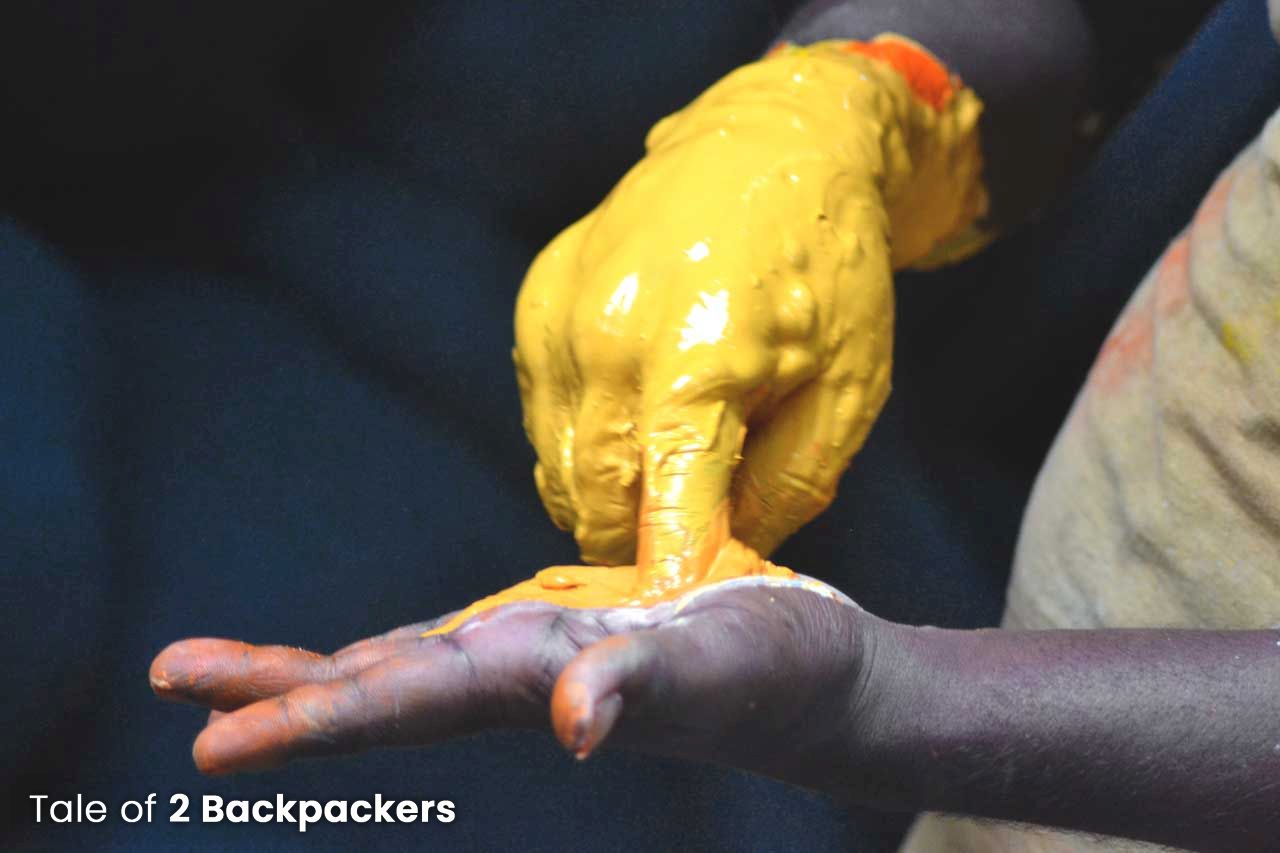
After the idol is made, the next step is to decorate it with embellishments. Saree, dhoti or any cloth are adorned on the idols. Interestingly, the dresses worn by the idols are selected keeping in mind the changing times and demand. Sometimes the entire idol is made out in clay including the hair and dresses.
Usually, there are three types of decorations for the idols – Daaker saaj, Rangtaa Saaj and Sholar Saaj.
In earlier days, Daaker saaj was done by special thin sheets of silver that used to arrive by post (daak) from Germany. Hence, the name for this decoration was given daaker saaj (daak means post and saaj means decoration). I am sure, today these embellishments are found in Kolkata itself and we do not have to look towards Germany for it.

Rangtaa Saaj was done by thin beaten sheets of gold. Nowadays, neither silver nor gold is used, but the name has remained. Finally Sholar saaj is done by decorating the idols with white shoal or pith. Shola is obtained from the fleshy, white interiors of the bark of pith plants which are found in marshy areas of West Bengal and Bangladesh. Sholaar Saaj used to be the most popular one because of its pristine look. Nowadays, the idols are decorated in various ways other than these three traditional decorations.
Traditionally, the priest must visit the house of a prostitute and beg for punya mati (blessed soil) from her backyard. If she refuses, the priest has to request her until she happily gives him the soil.
The idol makers of Kumartuli
More than 450 workshops are there in the lanes of Kumartuli. The skilled artisan regularly create idols of gods, goddesses and models for various other purposes. The time before the Durga Puja is the busiest in the year, though Bengalis have celebrations and festivals all round the year. Even before the Durga Puja, the artisans of Kumartuli are busy with Ganesh puja, Viswakarma puja. And after the Durga Puja comes Laxmi Puja, Kali Puja and Saraswati Puja.
Most of the Kumrtuli idol makers are old working in their small dimly lit rooms. They have been making the idols for years. A typical workshop of the artisan is usually a rectangular room having an entrance facing the road or lane. If you enter the workshop, you will find rows of idols kept on either side. Idols in various stages of completion will be on display. The major problem faced by the Kumartuli idol makers is the rain. Durga Puja is held just after the monsoon and it becomes difficult for them to sundry the clay idols. Sometimes the artisans even use Bunsen burner flame and blowers to dry them.
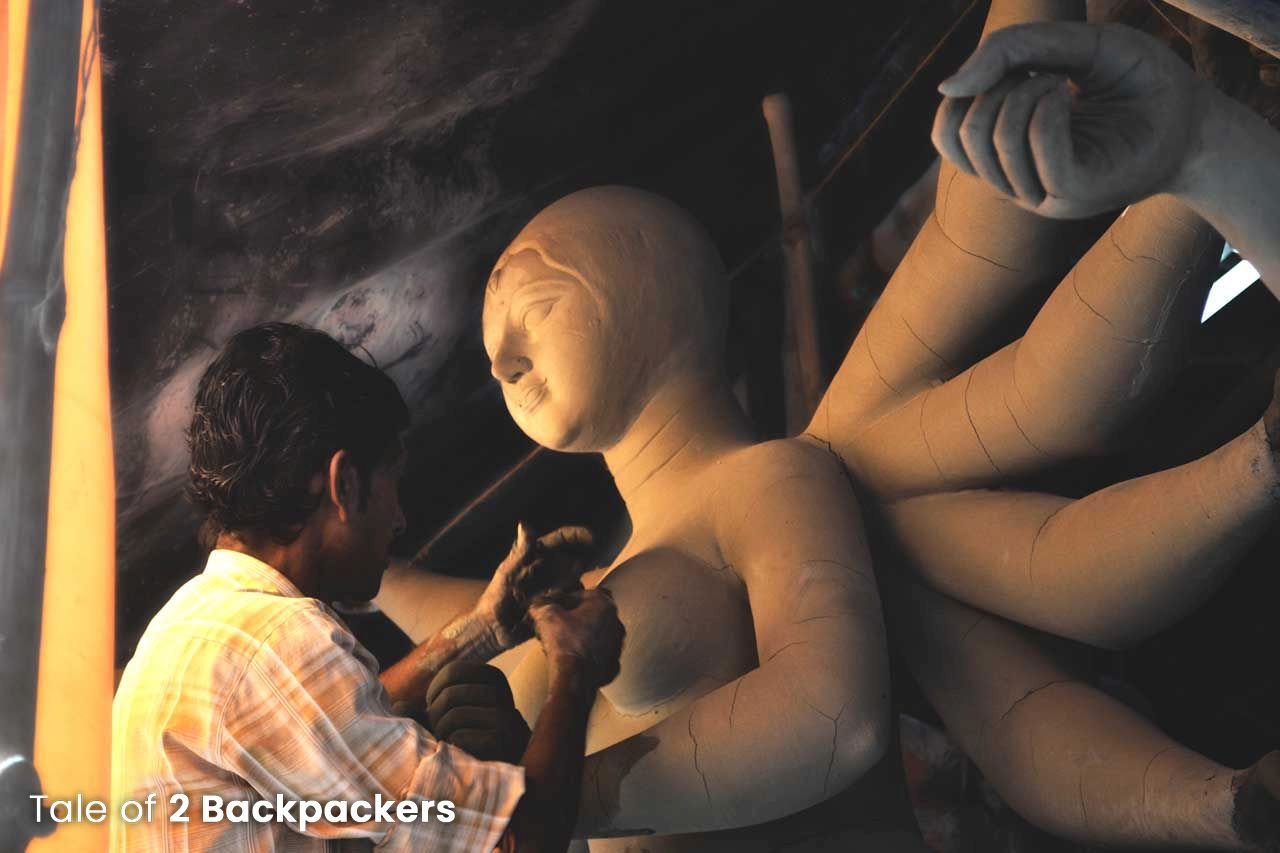
The women sculptors of Kumartuli
It is ironical to note that while we worship the demon slaying Goddess in Durga Puja, the women of the potter colony have found themselves in a gender biased role. Traditionally, making of idol is a male dominated task and women were usually discouraged from entering the working studios.
However, of late, many women are finding their way into the male dominated area and also proving their mettle. If you visit Kumartuli, look out for the work of Maya Pal, Kakuli Pal and China Pal.
Kumartuli – the future
Most of the Kumartuli idol makers are now in their old age. The current generation are looking for alternative career options as the monetary benefits in this profession are low. It is sad to see that when the theme pujas spend so much money on the pandal (marquees) and decorations, they do not want to give these artisans their due. If the craftsmen keep a high price, often the idols remain unsold. Also the sharp rise in the price of the raw materials has hurt the idol makers adversely. The older kumors (potters) lament the loss of their legacy. They reminisce about the past where the kumors were invited by the rich families to cast Durga idols.

There is also the incessant pressure of commercialisation that is resulting in many of the young artisan to defy their traditions. With time, style of the idols has changed. Nowadays, the organisers of Durga Puja are keener on theme-based celebration and for this they are hiring professional artists. This advertently hurts the Kumartuli idol makers.
These days, the kumors are trying to reinvent themselves. They are also making sculptures, decorative items and others. After all, they too have to make their living. Nowadays Durga Puja celebration is gaining prominence among the Bengalis outside West Bengal as well as from USA, Europe, Middle East and Africa; in short any place that has a Bengali population! In this scenario, the demand for the idol of the goddess comes from other states of India as well as from abroad. The Kumors have now become tech-savvy and many of them are having websites of their own.
Kumartuli is a place of the very gifted and talented artisans. As the soiled and experienced hands of the Kumartuli idol makers so beautifully craft every nuances of the Goddess with much care and respect, we can simply watch them awe-struck. Indeed these craftsmen are blessed to bring alive the Goddess with such dexterity.
We usually visit Kumartuli before the Durga Puja. It is always a new experience to watch how the artists bring life to these clay idols. After all, we Bengalis consider Goddess as a member of our family. The Kumartuli idol makers put a part of themselves in shaping the idols that we call our mother!

How to reach Kumartuli?
- Kumartuli is situated in Northern part of Kolkata very near to Bagbazar area. You can reach Kumartuli by hiring a cab or any public transport and it takes 25 to 30 minutes from Sealdah railway station.
- Alternatively, you can come to Bagbazar Railway station using circular railways and take a walk along the river Hooghly for 10 minutes before reaching Kumartuli.
- The nearest metro station is Sovabazar Metro. Kumartuli is 5-7 minutes walking distance from the metro.
You can go to Kumartuli any time during the year to see the artisan at work. The month before Durga Puja is however the busiest and you can see the best work. A nominal fees of Rs 10 is taken for entering the Kumartuli lanes.
A few tips for visiting Kumartuli
- It is better to visit early in the morning.
- Wear comfortable dress and shoes as you have to walk around.
- Please be careful with your cameras and gadgets so that you do not break off or damage any of their craft.
- It is always better to ask permission before entering any workshop and taking photographs.
- Please be respectful towards the artisan and their work.
Liked the post? Pin it for a later read!




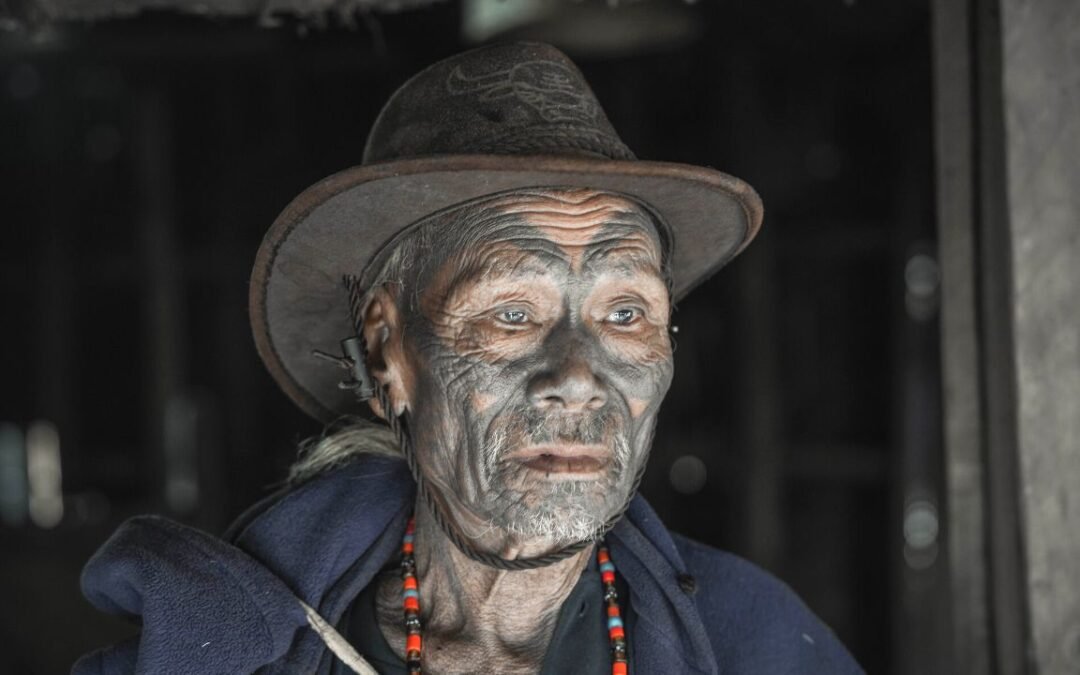
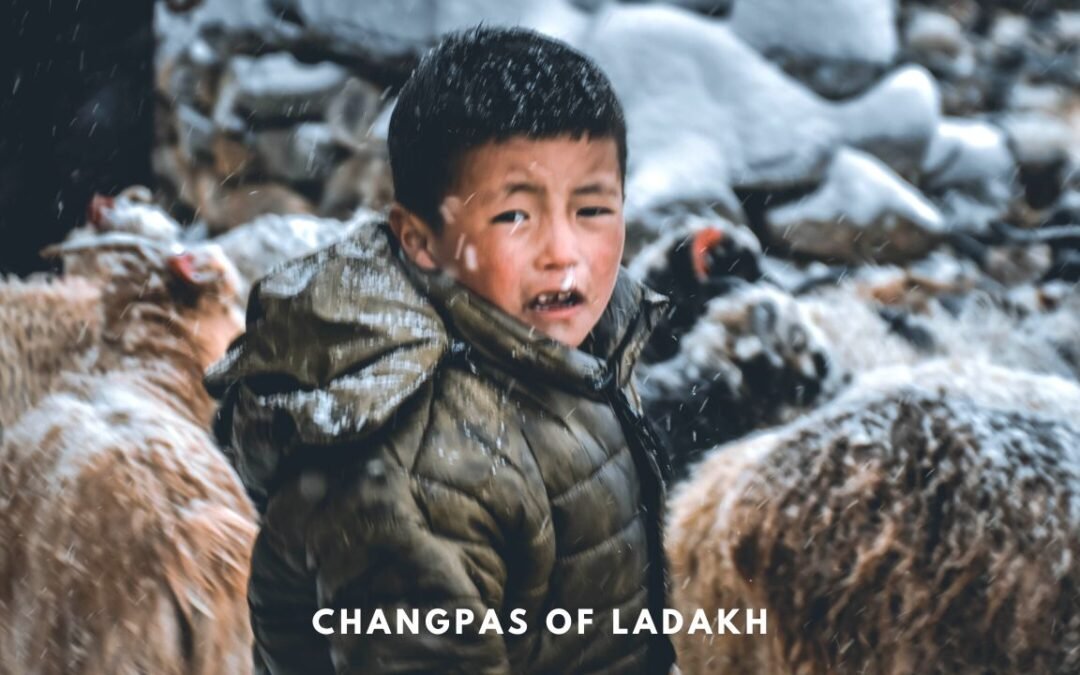

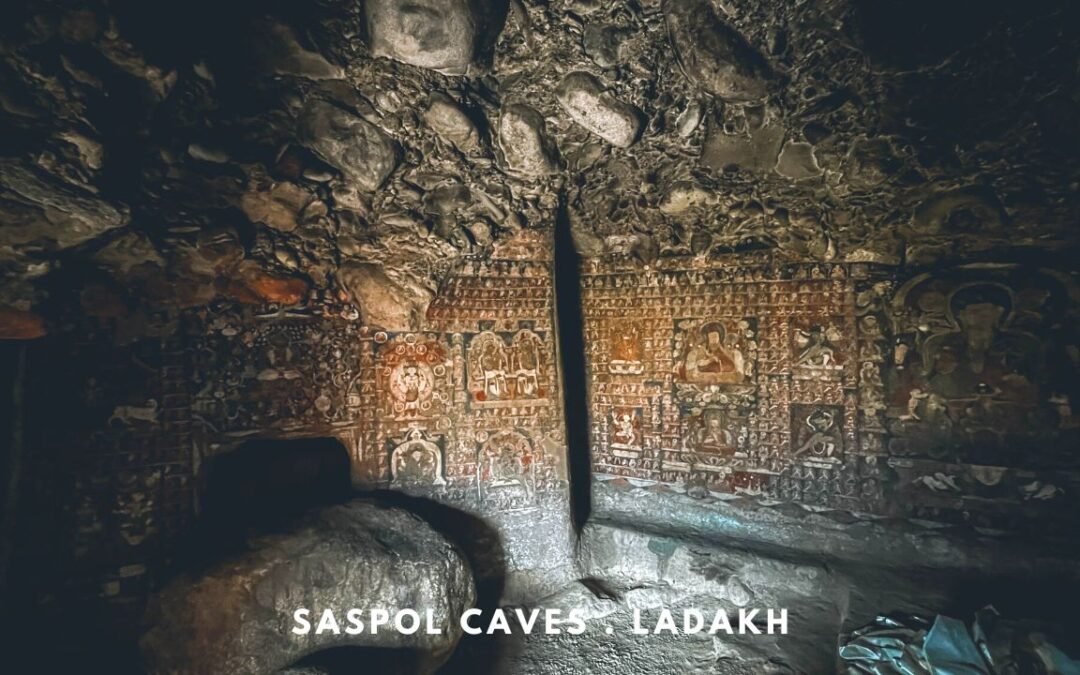



Beautiful pics.
I’ve been wanting to go see the Kali idol making process. Hope I’ll soon manage to explore the eastern side of India!
Wow! This culture has been in existence since 1700s! Wow! That’s a lot of heritage associated with it!
Quite an interesting connection between Greek influence! There’s a connection with Germany too? Wow! That’s very amusing!
Glad to know that women are also now getting into the craft! Hats off to them!
Thank you! Please explore East India as well. It has some fascinating places.
Interesting that the potters didn’t have any reference to how the gods and goddesses looked. I’m not surprised that making the idols was typically a male dominated task. It seems that is how it is everywhere around the world regardless of the task. A very interesting process that I knew nothing about!
Thank you Elizabeth!
Very elaborate and interesting info. I was not aware of the black town and the naming of different paras. Mahisasura has distinct Apollonian style is good comparison. So good to know there are women sculptors too now. Hope to meet them some day.
Thank you Indrani Di! Come to Kolkata sometime. We will explore together. 🙂
Wow, I don’t think I realized how big the idols were until the image at the very end, they are HUGE! You did such a great job discussing the history of the Kumartuli idol makers. This is why I love reading travel blogs and traveling, you can learn about history and culture in places you’d never think to learn it. I’m amazed that the idols and the craft have such a history with the area that is intertwined with British rule, politics, religion, culture, really everything. It is interesting the idols were crafted in the image of European gods! Thanks for talking about the women who do the craft as well, I am sure their work is just as good if not better, and I hope they continue to excel at the work.
Thank you Susana. So good to know that you loved reading this article. Kumartuli is special to us.
Wow! So much work and detail does into creating these hand-made idols. I am always fascinated with the culture of other people. The festivals here sound so interesting!
Thank you Kristy! Yes, festivals in this part of the world are quite interesting. Please visit Kolkata once during the Durga Puja. You will love it.
Durga puja is huge in Kolkata. Amazed at the beautiful pictures you shared in this post and the detailed write up.
Yes, it is huge. Thanks Anahita!
I admire the dedication and craftsmanship of these many artists in creating these sculptures. The colors are so alive and unique. Hope they continue to pass-on this skills to the new generation of artisans.
Thank you so much! We hope for the same too.
I’ve always been fascinated by the process of the idol making, and it’s like your journey to Kumartuli really answers my curiosity. This was quite a virtual journey through your blog post. Looking forward to visit some day!
Thank you Seema! Glad that you liked the article.
This is a very well described process and I loved going through the history of the place. I did not realize how the puja became big in the 1700s. I somehow, thought it was always a huge thing before that. Now that you point out the impact of the European idols on the way the Indian demons are done, I can see the resemblance. Lovely reading this.
Thank you Ami.
I have never of these dolls before but they sure do seem interesting. It is sad to see that this task just like many tasks in the world id heavily dominated by males A very interesting process that I knew nothing about!
Kumartuli looks like an interesting place to be visited! Can’t wait to go there ?
Yes, it is indeed an interesting place. visit soon!
Just loved ur post so well explained every single thing step by step I really wish to see this once in my life time.
Thank you Smitha. Visit soon.
Such a detailed post which give readers like us complete info.
My IN laws stays in Kolkata but yet I haven’t got a chance to visit during Durga Puja.
Thank you Jenifer. Please visit Kolkata once during Durga Puja! Its a carnival time then.
Didn’t about the history of Durga Puja.. the article is well written and a naive can me got the full information which I was looking for related to the festival. Loved reading it..
Thank you Arpit!
Wow.. wat a beautiful blog itcis. U explained it so well. Evn i m from kolkata. But honestly didn’t know about this place. Durga puja is the most beautiful festival. But love the details of the idol making. It makes me love it more. It feels great to knw more about ur city.
Thank you so much. Glad that you liked it.
Would love to visit this place soon.. Great to know accessible by metro also
Thank you Sapna. Visit soon!
I have always admired these idols, especially around the time of Durga Puja. Never knew the intricacies involved in making of these idols. Thanks for your detailed blog post, I feel I know a lil bit now ?
What a beautiful description of this place and the entire process of idol making
Thank you Sanjay!
It’s so interesting to read about the Kumartuli idol makers. I particularly loved knowing intricate details about their art especially the fact that they were influenced by the European sculptures of the classical Greek pantheon. It was also amazing to know that their art is giving them recognition and some of them even have websites!
Thank you Khushboo! Cant wait to show you Kumartuli and Kolkata! 🙂